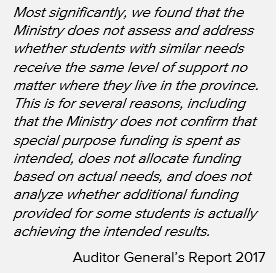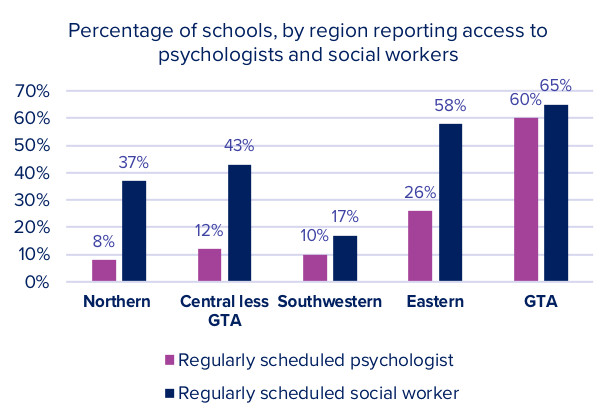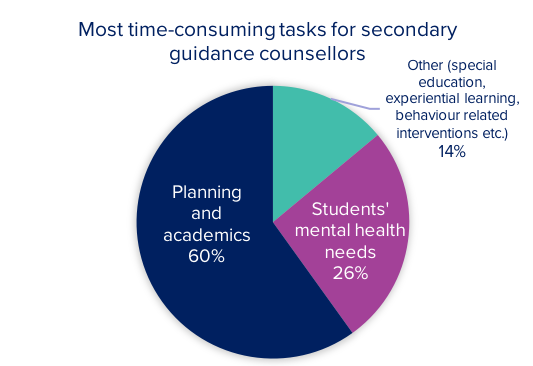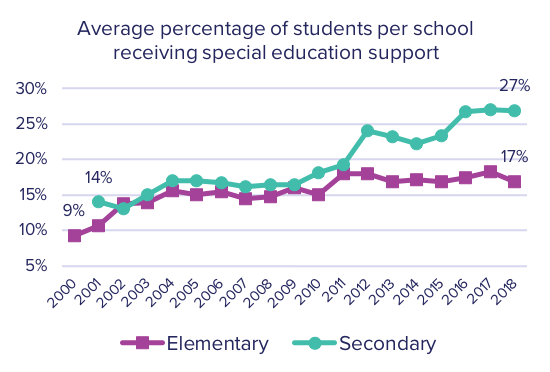Funding education in Ontario – Time for a review
Ontario’s government has committed to balancing the budget by 2023. To do this, the government says it will “end waste by halting unnecessary spending…reinventing the way government delivers services…” (Ontario Budget, 2019).
Education is one of the areas where the province sees a potential pathway to reduce spending.
Balancing the budget and reducing funding for education
In its education funding announcements for 2019, the Ministry of Education reduced the funding school boards receive in the Pupil Foundation Grant – which covers everything from teachers to school supplies – by more than $630 million. In addition, the $235.4 million Local Priorities Fund was withheld pending labour negotiations. These reductions come at a time when enrolment in K to 12 education is increasing and inflation overall stands at 2%.
The largest revenue reduction for school boards came as a result of a change to the formula that calculates how much funding boards receive for classroom teachers in grades 4 to 12. This funding change – often referred to as “class size funding” – will result over time in the loss of more than 4,000 teaching positions. Other funding reductions will reduce boards’ capacity to fund staff such as early childhood educators and support staff.
The loss of funding for teaching positions in secondary school may have the largest long-term impact – reducing school boards’ and schools’ capacity to provide both a wide range of course choices and a range of class sizes to their students. The loss of funding for teacher positions in grades 4 to 8 may also have an impact on boards’ capacity to provide specialist teachers for senior elementary grades.
Spending on education provides a substantial return on investment
While the aim to “get our books in order” is laudable, People for Education wishes to point to evidence that clearly shows the positive return on investment of spending on education.
We remind the government that according to the Conference Board of Canada, each dollar spent on education generates $1.30 in total economic benefit to Ontario. As economist and Nobel laureate James Heckman says, “Investing in children results in increased productivity, higher income, better health, more family investment, upward mobility, and reduced social costs.”
Review of education funding overdue
For a number of years, People for Education, Ontario’s Auditor General, the Ontario Student Trustees’ Association and others have called for a thorough review of Ontario’s education funding formula, some parts of which have not been revised since the formula was created in 1997.
In 2002, a government-appointed commission recommended that every five years, the Ministry of Education should undertake a comprehensive overall review of the formula.
It is now 2020, and no such review has taken place.
Over the last two decades, there have been massive changes to demographics and technology, and many are calling this era the 4th industrial revolution. There have been advancements in education research and there is emerging agreement about the skills and competencies students require for long-term success.
Over the same period, there have been few substantial changes to Ontario’s education funding formula.
This spring, the government laid out a number of goals for education, including a renewed focus on transferable skills, a plan to modernize classrooms across the province, support students’ mental health, and introduce extensive online learning.
To support these goals, People for Education recommends that – rather than making small changes to the Grants for Student Needs, and rather than eliminating teacher positions – the province should conduct a comprehensive review of the funding formula.
Areas that require review or change:
Funding for classroom teachers
Recent changes to class size funding will limit schools’ and boards’ capacity to deliver a range of courses to students – particularly those in high school. Over the last few months, boards across the province have released lists of courses to be cancelled. They include everything from specialized grade 12 science courses, to arts and technology courses and senior courses in economics.
In addition, a number of school boards have been working to “de-stream” grades 9 and 10 by supporting most or all students to enrol in Academic courses (as opposed to Applied). Boards are undertaking this work in order to support more students to graduate. Under the previous class size funding model, boards had the flexibility to provide smaller class sizes and increased supports for students in these “de-streamed” classes. This year’s funding changes will limit boards’ capacity to support students so that they have an equitable chance for success.

Funding for rural and Northern schools
People for Education’s evidence shows that areas with a large number of small schools are less likely to have vital staff such as guidance counsellors, psychologists, teacher librarians, and arts specialists.
Many adjustments have been made to funding for small, remote and northern schools over the last twenty years, but none have truly addressed the geographic inequities.
Funding for the arts and technology
Students learn a wide range of vital skills through the arts and through the use of technology. Ontario’s education funding formula currently has no targeted funding for the arts. Funding to cover hard costs for technology – computers, software, classroom materials etc. – has not increased in 10 years, and there is limited funding to support increased use of digital tools and online learning.
Results from People for Education’s 2019 Annual Ontario School Survey show that both the arts and technology are often supported in schools through parent fundraising – an inherently inequitable method of supporting these foundational resources and programs.
Funding to promote students’ mental health
In their responses to People for Education’s Annual Ontario School Survey, principals report increasing challenges in meeting the needs of students struggling with mental health issues, and they say that students have insufficient access to guidance counsellors and professional supports such as social workers and psychologists.
While progress has been made on a number of fronts including provincial funding for Mental Health Leads in school boards and mental health workers in secondary schools, the ratio of students to guidance counsellors remains very high. Currently, guidance counsellors are funded at a rate of 1 counsellor for every 385 students in grades 7 to 12. In 10% of secondary schools in 2019, the student to guidance counsellor ratio was 687 to 1. This makes it difficult, if not impossible, for counsellors to support students’ mental health along with their academic requirements.
Funding for special education
Despite years of increases to special education funding and a number of changes to the formula by which funding is disseminated to boards, principals continue to report a lack of adequate resources to meet students’ special education needs.
Students whose parents can’t afford to pay privately must wait – sometimes years – for psycho-educational assessments, and the majority of Ontario principals report that there have been times when they have had to ask parents to keep their children home from school for safety reasons or because there are insufficient supports available.
In 2017, Ontario’s Auditor General reported that 80% of school boards spend more on special education than they receive from the province.
Changing funding to support a changing world
Demographics also plays a key role in education funding. Understanding who is in our schools and providing targeted funding to school boards to help students who may be at greater risk is a vital component of an effective funding formula. Currently, we lack all the information we need about our students, and in many cases, we are relying on out-of-date census data to identify where targeted funding is needed.
The world is changing rapidly. Students who started school this year will graduate in 2031. We need to ensure that they have the skills, competencies, knowledge and attributes necessary to meet the challenges they will face.
For education funding to work effectively in Ontario, it must be driven by goals for policy and programs that will support all our students to succeed.
References
Conference Board of Canada. (2019). The Economic Case for Investing in Education. Ottawa, ON.
Heckman, James. (2020). Top 20 Resources. The economics of human potential.
Ontario Ministry of Education. (2002) Investing in Public Education: Advancing the Goal of Continuous Improvement in Student Learning and Achievement. Report of the Education Equality Task Force. Toronto, ON: Government of Ontario.
Ontario Ministry of Education. (2017). Ministry Funding and Oversight of School Boards. Toronto, ON: Government of Ontario.
Ontario Ministry of Education. (2019). 2019-20 Education Funding: A guide to the Grants for Student Needs. Toronto, ON: Government of Ontario.
Ontario Ministry of Education. (2019). Backgrounder: Education that Works for You – Modernizing Classrooms. Toronto, ON: Government of Ontario.
Ontario Ministry of Education. (2019). Education Funding Technical Paper 2019-20. Toronto, ON: Government of Ontario.
Ontario Ministry of Education. (2019) Backgrounder: Mental Health Supports in Ontario Schools. Toronto, ON: Government of Ontario
Office of the Auditor General of Ontario. (2017). Chapter 3.08: Ministry oversight and funding for school boards In 2017 Annual Report, 1, 430-430 Toronto, ON: Author.
Ontario Ministry of Education. (2019). Restoring Respect for Taxpayers by Balancing the Budget and Reducing the Debt Burden. Toronto, ON: Government of Ontario.
OSTA-AECO. (2019). The Student’s Vision for Education.
People for Education. (2017). The Learning Opportunities Grant 2017. Toronto, ON.
People for Education. (2016). 2016 Annual report on schools: The geography of opportunity. Toronto, ON.
People for Education. (2018) 2018 Annual report on schools: The new basics for public education. Toronto. ON.
People for Education. (2019) 2019 Annual report on schools: What makes a school?. Toronto, ON.
People for Education. (2019). Supporting students’ mental health: A collective responsibility. Toronto, ON.
Schwab, Klaus. (2019). The Fourth Industrial Revolution. The World Economic Forum.
TDSB. (2018). Helping all Students Succeed. Director’s Response to the Enhancing Equity Task Force Report. Toronto, ON.
YRDSB. (2019). List of Courses Cancelled and/or Sections Reduced as a Result of Year One Implementation of Provincial Class Size Changes *as of June 6, 2019. Aurora, ON.
